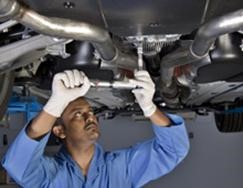Unit 9. Service technicians work environment
Section A. Work Environment
I. Scan the text “Work Environment” to find answers to these questions.
- How can you describe work environment of service technicians?
- Why do mechanics and service technicians receive injuries at their workplace?
- What do employers provide for them?

At most shops the work environment is well-lighted and properly ventilated. However some shops are drafty and noisy. Moreover, on a hot summer or frigid winter day shop temperatures are not always ideal.
Some shops that specialize in oil changes and lubrication use an arrangement commonly called a pit. Customers drive their vehicles into the shop. The mechanic then enters the pit to perform the work. Pit areas are typically not well-ventilated and can be hot during summer months. The very nature of the work also means that mechanics can seldom avoid handling greasy and dirty parts.
According to the latest Statistics, the rate of illnesses and injuries is higher for mechanics than the national average rate. Part of the risk comes from lifting heavy tools, equipment or parts. Other injuries, such as small burns, bruises or cuts, are caused from contact with hot or sharp parts, the need to reach into confined areas or having a tool slip under pressure. Strains and sprains were also common and were typically caused by overexertion.
Technicians may work as a team or be assisted by an apprentice or helper when doing heavy work, such as removing engines and transmissions. Many employers provide uniforms, locker rooms, and shower facilities.
Most automotive service technicians and mechanics work a standard 40 hour week. Some may work evenings and weekends to satisfy customer service needs.
Notes:
work environment, n.–производственные условия
workplace injuries, n. – производственные травмы
confined areas, n. – замкнутое, ограниченное пространство
slip, adj. – скользкий
overexertion, n. – перенапряжение sprain, n. – вывих
apprentice, n.–ученик, стажер strain, n.– растяжение
shower facilities, n.–душевыеlocker room, n. – раздевалка
satisfy customer needs, v.–удовлетворять запросы заказчика
Section B. Auto Mechanic Safety
I. Read the text “Auto Mechanic Safety Tips” and say why safety is critical for mechanics.
Auto Mechanic Safety Tips
Automotive service technicians and mechanics usually can avoid serious accidents if safe practices are observed.
Safety is critical for mechanics. Even in the smallest shop, a safety plan helps to prevent expensive and painful accidents, including slips and falls, exposure to toxic chemicals, electrical shocks and different injuries, including back injuries caused by improper lifting. First of all safety involves keeping tools in good working condition.
Personal protection includes relatively simple and inexpensive measures that protect the mechanic's hands, eyes, feet and ears.
Gloves protect the hands from burns from hot engines, irritation caused by caustic chemicals and cuts caused by exposure to sharp or protruding objects.
Safety goggles or protective glasses with side shields protect the eyes from injury caused by flying debris while grinding or welding.
Sturdy shoes or boots with nonskidsoles and steel toes prevent falls and protect the feet from injury caused by heavy objects.
Disposable earplugs protect the ears from loud noises caused by impact tools, engines and compressors.
Additional safety measures include tying up loose hair and avoiding loose clothing and jewelry.
Painter’s masks can help decrease the chance of inhalation injury during auto body painting, and a welder’s mask must be worn when welding, to protect the welder’s eyes from arc injuries. Additionally, simple inhalation masks should be worn during some sanding and cleaning tasks.
Safe use of machinery involves knowledge of the workings of each piece of machinery, including awareness and identification of potential hazards. Regular maintenance and inspections can reveal any potential problems, which should be fixed immediately. Electrical cords and sockets on small hand-held tools and lamps should be inspected regularly and replaced when they begin to wear.
Notes:
safe practices, n. – техника безопасности
personal protection, n. – индивидуальная защита
disposable earplugs, n.–одноразовые затычки для ушей
gloves, n.–перчатки
caustic chemicals, n.–щелочь protruding, adj.–торчащий наружу
safety goggles, n.–защитные очки debris, n.–осколки
sturdy, adj.–прочный nonskid, adj.–нескользящий
cord, n.–шнур wear, v. –изнашиваться
inhalation, n.–вдыхание arc, n.–контактно-дуговая сварка
Morozova О.N., Ilina I.Y.Тамбов2015